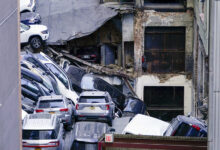
Shanghai has switched off decorative lighting amid soaring electricity demand caused by a heatwave

A child visits the Bund at night on August 22, 2022 in Shanghai, China. © Yin Liqin / China News Service via Getty Images
The lights are off on Shanghai’s riverfront skyscrapers and other buildings that give China’s economic hub its iconic look. City officials have said the measure is aimed at alleviating pressure on the national grid amid soaring electricity consumption caused by a heatwave.
In a statement released on Sunday, officials announced that “landscape lighting” in the city’s famous Bund district would be switched off for two days starting on Monday. The same measure will apply to billboards and video screens on both sides of the Huangpu River, the city authorities clarified.
The decision comes amid an ongoing heatwave that has hit several provinces in China and sent electricity consumption surging. With temperatures reaching a sweltering 45 degrees Celsius (113 degrees F), increased use of air conditioners has pushed power demand up considerably. Moreover, water levels in parts of the Yangtze River, China’s key inland waterway, have fallen significantly, putting yet more pressure on the hydroelectric plants that supply electricity to some of China’s most developed and power-consuming economic centers.


So grave is the situation that on Sunday the authorities in the southwestern Sichuan province extended for four more days a previously imposed power rationing scheme for industrial consumers.
“Since July of this year, the province has faced the most extreme high temperatures, the lowest rainfall in the corresponding period in history… {and} the highest power load in history,” officials explained.
The decision has seen several car factories, including those operated by Toyota and Elon Musk’s Tesla, halt production, as reported by Chinese news outlet Caixin.
Some experts have already warned that the power cuts in Sichuan could affect global supply chains, given that the province is also home to some major parts manufacturers.




